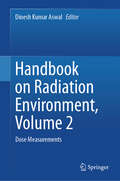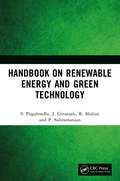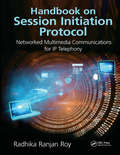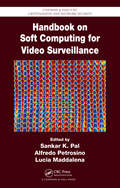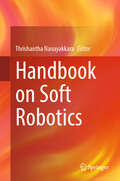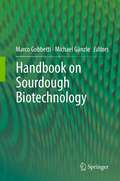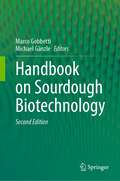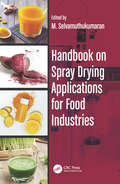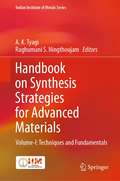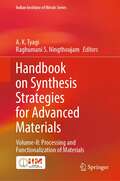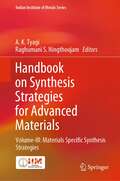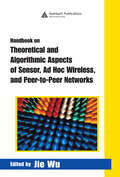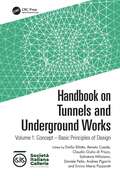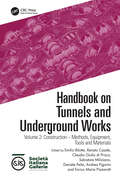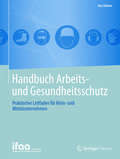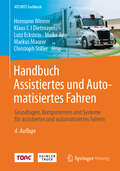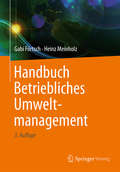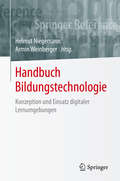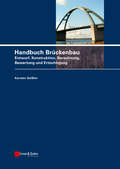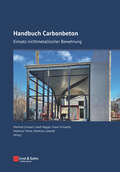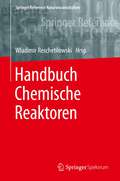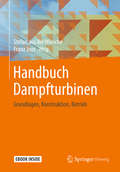- Table View
- List View
Handbook on Radiation Environment, Volume 2: Dose Measurements
by Dinesh Kumar AswalThe handbook aims to provide a comprehensive resource for understanding ionizing radiation dosimetry, catering to experts, policymakers, and interested readers. The content of the handbook is focused on two main aspects of dose measurements: external dosimetry and internal dosimetry. The section on external dosimetry covers fundamental principles and discusses monitoring techniques across various environments, such as nuclear, industrial, research, and medical facilities. It also covers advanced topics like Bayesian inference and retrospective dosimetry. The internal dosimetry section explores radionuclide biokinetics, simulation techniques, dose evaluation, and monitoring methods. Specific scenarios, such as radon inhalation and off-normal conditions, are addressed, highlighting the importance of precision and intervention. The handbook serves as a comprehensive resource for students, academicians, scientists, engineers, and policymakers interested in seeking an in-depth knowledge of radiation dose measurements and its multi-faceted aspects in protecting human health and the environment.
Handbook on Renewable Energy and Green Technology
by P. Subramanian S. Pugalendhi J. Gitanjali R. ShaliniThis book is a collection and compilation of various principles of renewable energy technologies and explores how we can use the sun, wind, biomass, geothermal, tidal and water resources to generate energy in a more sustainable form. Each chapter begins with the fundamental theory behind each technology illustrated with clear figures to understand the principle and applications. It also explains the fundamentals of energy, including the transfer of energy, as well as the limitations of natural resources. Starting with solar and wind energy, the text illustrates how energy from the sun, wind and water is transferred and converted into electricity. Other chapters cover methods of energy conversion, biomass energy, biofuel production and other new and renewable sources of energy such as geothermal, hydro, tidal, and ocean energy. This book is a collection of various principles of renewable energy technologies and explores how we can use the sun, wind, biomass, geothermal, tidal and water resources to generate energy in a more sustainable form.
Handbook on Session Initiation Protocol: Networked Multimedia Communications for IP Telephony
by Radhika Ranjan RoySession Initiation Protocol (SIP), standardized by the Internet Engineering Task Force (IETF), has emulated the simplicity of the protocol architecture of hypertext transfer protocol (HTTP) and is being popularized for VoIP over the Internet because of the ease with which it can be meshed with web services. However, it is difficult to know exactly how many requests for comments (RFCs) have been published over the last two decades in regards to SIP or how those RFCs are interrelated. Handbook on Session Initiation Protocol: Networked Multimedia Communications for IP Telephony solves that problem. It is the first book to put together all SIP-related RFCs, with their mandatory and optional texts, in a chronological and systematic way so that it can be used as a single super-SIP RFC with an almost one-to-one integrity from beginning to end, allowing you to see the big picture of SIP for the basic SIP functionalities. It is a book that network designers, software developers, product manufacturers, implementers, interoperability testers, professionals, professors, and researchers will find to be very useful. The text of each RFC from the IETF has been reviewed by all members of a given working group made up of world-renowned experts, and a rough consensus made on which parts of the drafts need to be mandatory and optional, including whether an RFC needs to be Standards Track, Informational, or Experimental. Texts, ABNF syntaxes, figures, tables, and references are included in their original form. All RFCs, along with their authors, are provided as references. The book is organized into twenty chapters based on the major functionalities, features, and capabilities of SIP.
Handbook on Soft Computing for Video Surveillance (Chapman & Hall/CRC Cryptography and Network Security Series)
by Sankar K. Pal Alfredo Petrosino Lucia MaddalenaInformation on integrating soft computing techniques into video surveillance is widely scattered among conference papers, journal articles, and books. Bringing this research together in one source, Handbook on Soft Computing for Video Surveillance illustrates the application of soft computing techniques to different tasks in video surveillance. Wor
Handbook on Soft Robotics
by Thrishantha NanayakkaraThis book explains how to design and control a soft robot in understandable language. In addition, it provides a comprehensive coverage of the essential theory and techniques used in soft robotics that can be used by graduate students in soft robotics. The book covers several key areas in soft robots, ranging from design and fabrication to modelling and control. It also includes many case studies and examples. The book clearly explains mathematical concepts and uses illustrative explanation to help engineers and junior graduate students understand the physical meaning of the key concepts and approaches in soft robotics. Reading this book gives professional engineers and students a sound knowledge of soft robotics that they can take to their careers and research.
Handbook on Sourdough Biotechnology
by Marco Gobbetti Michael GänzleIn the last few decades, many efforts have been made to exploit sourdough's potential for making baked goods. Through the biotechnology of this traditional baking method, many sensory, rheological, nutritional, and shelf-life properties have been discovered and/or rediscovered. Bakery industries are greatly attracted by the potentials that sourdough presents, and new industrial protocols are being developed. To the best of our knowledge, there has been no single book dedicated to sourdough biotechnology, and which clearly demonstrate its potential. This book aims at defining and highlighting the microbiological, technological, nutritional, and chemical aspects of sourdough biotechnology. The book will be the first reference guide on this topic for the worldwide scientific, teaching and students communities, also opening a way of communication and transferring the main results to a more productive industrial application.
Handbook on Sourdough Biotechnology
by Marco Gobbetti Michael GänzleBread and leavened bakery products have been essential to human nourishment for millennia. Traditionally, bread production has relied on the use of sourdough as a leavening agent and to impart a characteristic quality to baked goods. In recent years, improved understanding of the biodiversity and microbial ecology of sourdough microbiota, the discovery of new species, the improved management and monitoring of its meta-community and the commercialization of innovative products have vastly expanded the potential of sourdough fermentation for making baked goods. For example, raw materials such as cereals, pseudo-cereals, ancient grains, and gluten-free substrates, as well as a large number of baked good varieties (e.g., typical and industrial breads, sweet baked goods, gluten-free products) may benefit from advances in sourdough fermentation. In addition, biotechnological tools and culture properties have been discovered to improve both the shelf life and the sensory and textural qualities of baked goods, as well as their nutritional and health-promoting properties.Now in its second edition, the Handbook on Sourdough Biotechnology remains the only book dedicated completely to sourdough biotechnology with the contribution of the most experienced researchers from the field. It reviews the history of sourdough and the potential of sourdough fermentation in the production of bread and baked goods. A thorough discussion of the various processing steps includes the chemical properties of the raw matter, the taxonomy, diversity, and metabolic properties of starter yeasts and lactic acid bacteria, and the effects of sourdough fermentation on the shelf life and the sensory, textural, nutritional, and health-promoting properties of baked goods.
Handbook on Spray Drying Applications for Food Industries
by M. SelvamuthukumaranSpray drying is a mechanical process by which materials in liquid form can be converted into solid form such as powders. It is a rapid, continuous, cost-effective, reproducible and scalable process for producing dry powders from a fluid material by atomization through an atomizer into a hot drying gas medium, usually air. The Handbook on Spray Drying Applications for Food Industries deals with recent techniques adopted in spray drying systems for drying a vast array of food products, novel and emerging tools used for spray drying of antioxidant rich products, optimized conditions used for extraction and production of herbal powders by using spray drying techniques, and problems encountered during spray drying of acid and sugar rich foods and also various herbal powders. The book discusses the encapsulation of flavors by using the spray drying process providing a comparison with other encapsulation techniques. It reviews the retention of bioactive compounds and the effect of different parameters on bioactive compounds during spray drying of juice. Moreover, the book explains the effect of novel approaches of spray drying on nutrients. The book addresses strategies adopted for retention of nutrients and survival of probiotic bacteria during spray drying processing. It also identifies packaging material needed for enhanced product stability. The safety and quality aspects of manufacturing spray dried food products are discussed. Key Features: Describes the design of high performance spray drying systems Highlights the strategy adopted for maximizing the yield potential of various spray dried food products Discusses strategies adopted for retention of nutrients and survival of probiotic bacteria during spray drying process Contains charts, procedure flow sheets, tables, figures, photos, and a list of spray drying equipment suppliers This book will benefit entrepreneurs, food scientists, academicians and students by providing in-depth knowledge about spray drying of foods for quality retention and also for efficient consumer acceptability of finished products.
Handbook on Synthesis Strategies for Advanced Materials: Volume-I: Techniques and Fundamentals (Indian Institute of Metals Series)
by A. K. Tyagi Raghumani S. NingthoujamThis book presents state-of-the-art coverage of synthesis of advanced functional materials. Unconventional synthetic routes play an important role in the synthesis of advanced materials as many new materials are metastable and cannot be synthesized by conventional methods. This book presents various synthesis methods such as conventional solid-state method, combustion method, a range of soft chemical methods, template synthesis, molecular precursor method, microwave synthesis, sono-chemical method and high-pressure synthesis. It provides a comprehensive overview of synthesis methods and covers a variety of materials, including ceramics, films, glass, carbon-based, and metallic materials. Many techniques for processing and surface functionalization are also discussed. Several engineering aspects of materials synthesis are also included. The contents of this book are useful for researchers and professionals working in the areas of materials and chemistry.
Handbook on Synthesis Strategies for Advanced Materials: Volume-II: Processing and Functionalization of Materials (Indian Institute of Metals Series)
by A. K. Tyagi Raghumani S. NingthoujamThis book presents state-of-the-art coverage of synthesis of advanced functional materials. Unconventional synthetic routes play an important role in the synthesis of advanced materials as many new materials are metastable and cannot be synthesized by conventional methods. This book presents various synthesis methods such as conventional solid-state method, combustion method, a range of soft chemical methods, template synthesis, molecular precursor method, microwave synthesis, sono-chemical method and high-pressure synthesis. It provides a comprehensive overview of synthesis methods and covers a variety of materials, including ceramics, films, glass, carbon-based, and metallic materials. Many techniques for processing and surface functionalization are also discussed. Several engineering aspects of materials synthesis are also included. The contents of this book are useful for researchers and professionals working in the areas of materials and chemistry.
Handbook on Synthesis Strategies for Advanced Materials: Volume-III: Materials Specific Synthesis Strategies (Indian Institute of Metals Series)
by A. K. Tyagi Raghumani S. NingthoujamThis book presents state-of-the-art coverage of synthesis of advanced functional materials. Unconventional synthetic routes play an important role in the synthesis of advanced materials as many new materials are metastable and cannot be synthesized by conventional methods. This book presents various synthesis methods such as conventional solid-state method, combustion method, a range of soft chemical methods, template synthesis, molecular precursor method, microwave synthesis, sono-chemical method and high-pressure synthesis. It provides a comprehensive overview of synthesis methods and covers a variety of materials, including ceramics, films, glass, carbon-based, and metallic materials. Many techniques for processing and surface functionalization are also discussed. Several engineering aspects of materials synthesis are also included. The contents of this book are useful for researchers and professionals working in the areas of materials and chemistry.
Handbook on Theoretical and Algorithmic Aspects of Sensor, Ad Hoc Wireless, and Peer-to-Peer Networks
by Jie WuThe availability of cheaper, faster, and more reliable electronic components has stimulated important advances in computing and communication technologies. Theoretical and algorithmic approaches that address key issues in sensor networks, ad hoc wireless networks, and peer-to-peer networks play a central role in the development of emerging network
Handbook on Tunnels and Underground Works: Volume 1: Concept – Basic Principles of Design
by Emilio BilottaThe book provides a new, global, updated, thorough, clear and practical risk-based approach to tunnelling design and construction methods, and discusses detailed examples of solutions applied to relevant case histories. It is organized in three sequential and integrated volumes: Volume 1: Concept – Basic Principles of Design Volume 2: Construction – Methods, Equipment, Tools and Materials Volume 3: Case Histories and Best Practices The book covers all aspects of tunnelling, giving useful and practical information about design (Volume 1), construction (Volume 2) and best practices (Volume 3). It provides the following features and benefits: updated vision on tunnelling design, tools, materials and construction balanced mix of theory, technology and applied experience different and harmonized points of view from academics, professionals and contractors easy consultation in the form of a handbook risk-oriented approach to tunnelling problems. The tunnelling industry is amazingly widespread and increasingly important all over the world, particularly in developing countries. The possible audience of the book are engineers, geologists, designers, constructors, providers, contractors, public and private customers, and, in general, technicians involved in the tunnelling and underground works industry. It is also a suitable source of information for industry professionals, senior undergraduate and graduate students, researchers and academics.
Handbook on Tunnels and Underground Works: Volume 2: Construction – Methods, Equipment, Tools and Materials
by Enrico Maria Pizzarotti Daniele Peila Emilio Bilotta Renato Casale Salvatore Miliziano Andrea Pigorini di Prisco, Claudio GiulioThis book set provides a new, global, updated, thorough, clear, and practical risk-based approach to tunnelling design and construction methods, and discusses detailed examples of solutions applied to relevant case histories. It is organized in three sequential and integrated volumes: Volume 1: Concept – Basic Principles of Design Volume 2: Construction – Methods, Equipment, Tools and Materials Volume 3: Case Histories and Best Practices The book covers all aspects of tunnelling, giving useful and practical information about design (Vol. 1), construction (Vol. 2), and best practices (Vol. 3). It provides the following features and benefits: updated vision on tunnelling design, tools, materials, and construction balanced mix of theory, technology, and applied experience different and harmonized points of view from academics, professionals, and contractors easy consultation in the form of a handbook risk-oriented approach to tunnelling problems The tunnelling industry is amazingly widespread and increasingly important all over the world, particularly in developing countries. The possible audience of the book are engineers, geologists, designers, constructors, providers, contractors, public and private customers, and, in general, technicians involved in the tunnelling and underground works industry. It is also a suitable source of information for industry professionals, senior undergraduate and graduate students, researchers, and academics.
Handbook on Tunnels and Underground Works: Volume 3: Case Histories and Best Practices
by Enrico Maria Pizzarotti Daniele Peila Emilio Bilotta Renato Casale Salvatore Miliziano Andrea Pigorini di Prisco, Giulio ClaudioThis book set provides a new, global, updated, thorough, clear, and practical risk-based approach to tunnelling design and construction methods, and discusses detailed examples of solutions applied to relevant case histories. It is organized in three sequential and integrated volumes: Volume 1: Concept – Basic Principles of Design Volume 2: Construction – Methods, Equipment, Tools and Materials Volume 3: Case Histories and Best Practices This book covers all aspects of tunnelling, giving useful and practical information about design (Vol. 1), construction (Vol. 2), and best practices (Vol. 3). It provides the following features and benefits: updated vision on tunnelling design, tools, materials, and construction balanced mix of theory, technology, and applied experience different and harmonized points of view from academics, professionals, and contractors easy consultation in the form of a handbook risk-oriented approach to tunnelling problems. The tunnelling industry is amazingly widespread and increasingly important all over the world, particularly in developing countries. The possible audience of this book are engineers, geologists, designers, constructors, providers, contractors, public and private customers, and, in general, technicians involved in the tunnelling and underground works industry. It is also a suitable source of information for industry professionals, senior undergraduate and graduate students, researchers, and academics.
Handbuch Arbeits- und Gesundheitsschutz
by Institut für angewandte ArbeitswissenschDieses Handbuch dient als Praxisleitfaden für Arbeits- und Gesundheitsschutzbeauftragte. Es gibt Hilfestellung beim Aufbau der Organisation des betrieblichen Arbeits- und Gesundheitsschutzes. Dies soll Unternehmen dazu befähigen, basierend auf den gesetzlichen Anforderungen ein zum jeweiligen Betrieb passendes System zu installieren. Neben der rechtlichen Einordnung beschreiben die Autoren in kleinen Schritten und praxisgerecht die erforderlichen planerischen und organisatorischen Aspekte. Das Handbuch enthält Vorlagen und Checklisten. Diese können direkt verwendet und auf die eigenen betrieblichen Belange angepasst werden. Unternehmen, die das Handbuch nutzen und mit Leben füllen, haben damit die Grundlage für ein Arbeitsschutzsystem geschaffen, dass zu einem Arbeitsschutzmanagement ausgebaut werden kann. Dieses Handbuch wird Betriebspraktiker interessieren, ihnen hilfreiche Impulse für die eigene Arbeit sowie für die Umsetzung vor Ort geben.
Handbuch Assistiertes und Automatisiertes Fahren: Grundlagen, Komponenten und Systeme für assistiertes und automatisiertes Fahren (ATZ/MTZ-Fachbuch)
by Hermann Winner Markus Maurer Meike Jipp Lutz Eckstein Christoph Stiller Klaus C J DietmayerIn diesem Grundlagenwerk werden Systeme, die Fahrzeugführung unterstützen oder ganz übernehmen in Aufbau und Funktion ausführlich erklärt. Darüber hinaus enthält es eine Übersicht der Rahmenbedingungen für die Entwicklung solcher Systeme sowie Erläuterungen der angewandten Entwicklungs- und Testwerkzeuge. Die Beschreibung umfasst die heute bekannten Assistenzsysteme einschließlich des Ausblicks auf deren zukünftigen Entwicklungen. Speziell wird den vielfältigen Aspekten der Automatisierung des Fahrens Rechnung getragen, denn mit der Übertragung der Fahraufgabe an eine Maschine leiten sich viele neue Herausforderungen ab. Im Handbuch werden Funktionsprinzipien und Ausführungsformen die dazu erforderlichen Komponenten und Architekturen für die maschinelle Wahrnehmung, der Planung und der Aktorik erläutert. Der nutzergerechten Gestaltung der Mensch-Maschine-Schnittstellen von Assistenz- und Automatisierungssystemen wird ebenso Rechnung getragen wie die Diskussion zu den Herausforderungen für die Einführung des hochautomatisierten Fahrens ab Level 3. Besonderheiten von Systemen zum assistierten und automatisierten Fahrens bei Nutzfahrzeugen und Motorrädern runden den umfassenden Ansatz ab.
Handbuch Betriebliches Umweltmanagement
by Gabi Förtsch Heinz MeinholzIn kompakter Form stellt dieses Handbuch das notwendige Wissen für das betriebliche, nachhaltige Umweltmanagement zur Verfügung. Es ist als Nachschlagewerk zur Einführung und Fortschreibung eines Umweltmanagementsystems konzipiert. Darüber hinaus kann es als Lehrbuch bzgl. der Grundaspekte des betrieblichen Umweltmanagements verwendet werden.
Handbuch Bildungstechnologie: Konzeption und Einsatz digitaler Lernumgebungen
by Armin Weinberger Helmut NiegemannDas Handbuch vermittelt einen umfassenden Überblick über den aktuellen Erkenntnisstand zu Ansätzen und Befunden zur systematischen Gestaltung von Lernumgebungen in deutscher Sprache. Es präsentiert theoretische und methodische Grundlagen der Forschungsdisziplin Bildungstechnologie und stellt darüber hinaus konkrete Überlegungen an, wie diese wissenschaftlichen Grundlagen in praktischen Lehr-Lern-Kontexten umgesetzt werden können. Neben der systematischen Konzeption von Lernangeboten (Instructional Design) liegt ein weiterer Schwerpunkt beim Einsatz aktueller Informations- und Kommunikationstechnik, insbesondere digitaler, interaktiver Medien im Bildungswesen.
Handbuch Brückenbau: Entwurf, Konstruktion, Berechnung, Bewertung und Ertüchtigung
by Karsten GeißlerMit Brücken in Städten und Landschaften können Akzente gesetzt werden. Brückenbau ist ein Motor für technische Entwicklungen und leistet einen wesentlichen Beitrag zur Baukultur. Das vorliegende Buch ist ein Wegweiser für den optimierten Entwurf und die Planung von Brückenbauwerken. Neben der umfassenden Darstellung der Grundsätze des werkstoffübergreifenden Brückenentwurfes enthält es Erläuterungen und Berechnungsbeispiele zur Konstruktion und Bemessung von Massiv-, Stahl- und Verbundbrücken. Zum besseren Verständnis der Beanspruchungen werden Hintergründe zu den Einwirkungen und zum Sicherheitskonzept erläutert. Der Bewertung und Ertüchtigung bestehender Brücken ist ein gesondertes Kapitel gewidmet. Zusätzlich warden spezielle Aspekte detailliert behandelt, wie z.B. die Gleis-Tragwerk-Interaktion oder die dynamische Beanspruchung bei Eisenbahnbrücken. Zahlreiche Beispiele zu häufi gen Brückentypen, Hinweise zu Fußgängerbrücken und ein Überblick über die Elemente der Brückenausstattung runden das Werk ab. Der reiche Erfahrungsschatz des Autors aus der Planungs- und Prüfpraxis sowie aus der Tätigkeit als Gutachter und Hochschullehrer macht das Werk zu einem einzigartigen Handbuch.
Handbuch Carbonbeton: Einsatz nichtmetallischer Bewehrung
by Josef Hegger Frank Schladitz Matthias Tietze Matthias Lieboldt Herausgegeben von Manfred CurbachCarbonbeton ist die Bauweise der Zukunft. Angesichts der drängenden Aufgaben zur Begrenzung des Klimawandels und des sorgsamen Umgangs mit den begrenzten Ressourcen hat der Carbonbeton genau die richtigen Eigenschaften. Er spart mehr als 50 % Ressourcen, insbesondere Sand, und reduziert den CO2-Ausstoß um bis zu 70 %. Carbonbeton ist somit ein Game-Changer, der auf das Bauen ebenso Auswirkungen hat wie auf das Erscheinungsbild und die Nutzung der gebauten Umwelt. Zusammen mit der sehr langen Lebensdauer, dem Werterhalt, der Bezahlbarkeit und der Ästhetik verdient er die Bezeichnung einer disruptiven Innovation. Nach Entstehung der Idee vor fast 30 Jahren und nach intensiver Grundlagenforschung im Rahmen zweier Sonderforschungsbereiche der DFG konnte die erforderliche anwendungsorientierte Forschung durch das Konsortium C3 - Carbon Concrete Composite durchgeführt werden. Dieses vom Bundesministerium für Bildung und Forschung im Rahmen des Zwanzig20-Programms unterstützte Großprojekt hat gezeigt, dass Carbonbeton in die Praxis überführt werden kann. Hierzu haben über 160 Partner alle notwendigen neuen Kenntnisse erarbeitet. Höhepunkt und zusammenfassendes Ergebnis ist der CUBE, das erste komplett aus Carbonbeton gefertigte Gebäude. Es besteht aus der "Box", die die Möglichkeiten wirtschaftlichen und modularen Bauens zeigt, und aus dem "Twist", der die Entstehung einer neuen Architektursprache visualisiert. Das vorliegende Buch fasst den heute vorliegenden Stand des Wissens zu Carbonbeton von den Grundlagen bis zur Anwendung zusammen und darf daher als Standardwerk des Neuen Bauens bezeichnet werden.
Handbuch Chemische Reaktoren: Chemische Reaktionstechnik: Theoretische und praktische Grundlagen, Chemische Reaktionsapparate in Theorie und Praxis (Springer Reference Naturwissenschaften)
by Wladimir ReschetilowskiDieses umfassende Handbuch - in deutscher Sprache einzigartig - stellt die chemische Reaktionstechnik ausführlich vor und behandelt insbesondere die Vielzahl von Chemiereaktoren, die in der chemischen Industrie zum Einsatz kommen, inklusive ökologischer und ökonomischer Aspekte.
Handbuch Dampfturbinen: Grundlagen, Konstruktion, Betrieb
by Stefan aus der Wiesche Franz JoosDas Fachbuch behandelt die Grundlagen, die Konstruktion und das Betriebsverhalten von Dampfturbinen in aktueller Form. Die wichtigsten Fragen zu Dampfturbinen werden als zeitgemäßes Kompendium für fortgeschrittene Studierende, Berufseinsteiger und Ingenieure in der Praxis umfassend und detailliert dargestellt. Nach Grundlagen, Bauteilen und Komponenten werden ausgewählte Ausführungsbeispiele beschrieben und diskutiert. Praxisgerechte Beispiele und Fragen zum Betrieb und Einsatz von Dampfturbinen runden die Darstellung ab.
Handbuch Digital Farming: Digitale Transformationen für eine nachhaltige Landwirtschaft
by Jörg Dörr Matthias NachtmannDas Handbuch Digitale Farming beleuchtet die technologischen, wirtschaftlichen, gesellschaftlichen und rechtlichen Perspektiven der digitalen Transformation. Die Autorinnen und Autoren der einzelnen Kapitel erläutern den Stand der Technik und die Entwicklung von Geschäftsmodellen, so dass die Leserinnen und Leser daraus Schlüsse für ihre eigene Organisation ziehen können. Zudem geben sie einen Ausblick auf Trends und weitere Entwicklungen. Das Handbuch liefert technologische Fakten von renommierten Experten und konkrete Geschäftsbeispiele von erfahrenen Unternehmen und Start-ups. Es richtet sich an Landwirte, Betriebs- und Unternehmensleiter, Entscheider und Entwickler digitaler Tools und Strategien in der Agrar- und Ernährungswirtschaft, sowie an Wissenschaftler und Studierende. Das Handbuch gibt Einblicke in die Diskussion, welchen Beitrag die digitale Landwirtschaft zur Umsetzung des Green Deal, der Farm to Fork Strategie und der neuen Gemeinsamen Agrarpolitik leisten kann.
Handbuch Eisenbahninfrastruktur
by Jia Liu Jochen Holzfeind Ferdinand PospischilDie Eisenbahninfrastruktur weist eine große Anlagenvielfalt mit komplexen Wechselwirkungen auf. Diese Bandbreite und Komplexität von Bahnanlagen spiegelt das Nachschlagewerk mit Beiträgen von mehr als 50 Fachkräften aus allen Bereichen der Eisenbahninfrastruktur aus Deutschland und Österreich wider. Das Handbuch zeigt den erreichten Stand der Technik und berücksichtigt aktuelle Vorschriften. In den einzelnen miteinander vernetzten Kapiteln werden die technischen und operativen Grundlagen und Zusammenhänge der Eisenbahninfrastruktur sowie der Interaktion von Infrastruktur und Fahrzeug in Maß und Zahl dargestellt. Trassierung und Gleisplangestaltung, Eisenbahnoberbau, Kabelanlagen, Sicherheit, Instandhaltung und Anlagenmanagement sind nur einige der behandelten Fachgebiete. Die knappe aber fakten- und detailreiche Darstellung mit Bildern, Zeichnungen, Diagrammen und Tabellen ermöglicht einen schnellen Zugriff auf das gesuchte Wissensgebiet und die nachzuschlagenden Einzelheiten. Querverweise unterstützen das Verständnis der Komplexität und engen Vernetzung der verschiedenen Ingenieursdisziplinen auf dem Gebiet der Eisenbahninfrastruktur.Das Handbuch richtet sich an praktisch tätige Ingenieur*innen, Planungs- und Consultingingenieur*innen sowie an Führungskräfte und Entscheidungsträger in Unternehmen des Bahnsektors. Darüber hinaus eignet sich das Buch als umfassendes Nachschlagewerk für Studierende und Lehrende in Studiengängen des Verkehrs- und Bauingenieurwesens.
